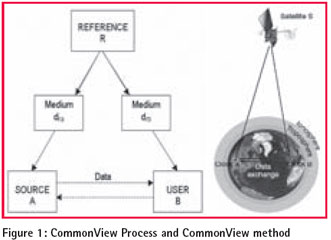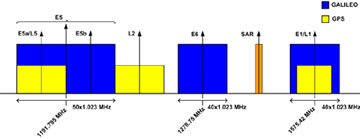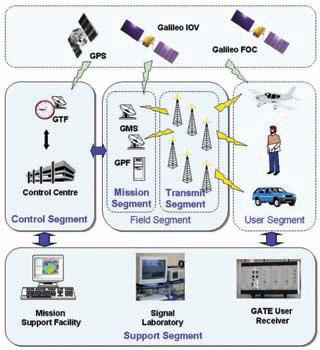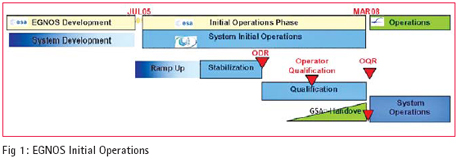Articles in the GNSS Category

A central issue in designing complex networked systems for critical applicative domains is the possibility of keeping each node of the network synchronized with respect to a given system time scale. The problem is even more critical when the synchronization accuracy determines directly the performances of the whole system.

E5 band (1164 -1215 MHz), composed of E5a and E5b bands, is part of the spectrum allocated by ITU for new Radio Navigation Satellite Services in 2000. E5 signal has the wider bandwidth (51.150 MHz) never used in satellite navigation. Galileo E5 signal is composed by two data components and two pilot components broadcasted together by means of the multiplexing scheme AltBOC(15,10). E5a band will be used for Freely/NAV message (Open Service) and the codes of data and pilot components are uncripted, E5b band will be used for Integrity/NAV message for Safety of Life and Open Service. Integrity of signal is probably the most advanced service introduced by Galileo [1]. One of the main feature of E5 band is that the signal can be received in two ways: the first is to filter and demodulate only one of side bands E5a or E5b (see Fig. 1) the second is to process the overall received signal containing the components of both bands [2],[3]. In this sections is considered the second way because it will be adopted by professional receivers and this will avoid to obtain all the advantages of Galileo signal. E5 is the most promising signal in terms of performance in multipath environment and positioning for critical applications but also the most challenging for a receiver or a simulation. In this paper will be presented the simulation of the transmission and reception of E5 signal. It will be first described the generation of codes, then it will be illustrated Galileo AltBOC(15,10) signal structure and its differences with a conventional AltBOC, it will be shown a way for the generation of that signal and some basic characteristics for the development of a software receiver for E5.

GPs is running since more than a decade. There are user groups in all domains relying on the provided information. GPS is even used in safety critical environment, but there have been no certification of the GPS system nor are there any plans to do so. Within aviation, GPS is assumed to fulfill requirement on reliability and availability based on observations of the past. Is the discussion in Europe about certification of the Galileo SIS (Signal in Space) just another proof for the bureaucratic overhead imposed on the Galileo project? NavCert as part of the TÜV SÜD group is focused on certification in the area of positioning and navigation.

Although Global Navigation Satellite Systems (GNSS) technology is developing rapidly, the major disadvantage of GNSS will still exist even when the European Galileo system is fully operational, that is, signal blockage due to obstructions and the low power of the signals. The combination of GNSS with a self-contained inertial navigation system (INS) provides an ideal solution, which can not only address the weakness of GNSS and but also bound…

Ground segment of GAGAN i.e. Indian Reference Station (INRES) at Delhi, Kolkatta, Guwahati, Portblair, Ahmedabad, Banglore, Jammu and Trivanthapuram is in place. Except Portblair, other stations have been connected to Indian Master Control Center (INMCC) with fiber optic cable in synchronous loop mode. Portblair is connected through dedicated satellite communication network. Its integration and connectivity test with seven INRES with INMCC have been completed. The INRES data is being received through fiber optic cable at INMCC Banglore for corrections and validation checks of the erroneous data. Preliminary Site Acceptance Test (PSAT) of GAGAN ground element was conducted in May 2006 with help of satellite emulator.

GATE is a ground-based realistic test environment for developers of receivers, applications and services for the future satellite navigation system Galileo. GATE is currently being builtup and as from beginning of 2008 – several years before Galileo becomes fully operational – Galileo signals will be emitted by 6 earth-fixed transmitters in the area of Berchtesgaden, located in the southeast of Germany in the German Alps. This will provide the opportunity for receiver, application and service developers to perform realistic field-tests of hardware and software for Galileo at an early stage. In this way GATE will also support German and European products for Galileo entering the market.
While the motivation of the US groundbased ranging test bed Yuma in the 70’s was to prove the concept of satellite navigation, no one doubts that Galileo will work from a conceptual point of view. However, it is still an ambitious technological project, introducing a signal structure far more sophisticated than the GPS C/A Code. In fact there are three major mission objectives to be covered by GATE – Signal Experiments, Receiver Testing and User applications.

Any look into the crystal ball of (even the near) future is fraught with caveats, error, and less than perfect clarity. However, certain extrapolations and not-so-wild guesses do exist.
GNSS, General – Existing (and near term proposed) systems will continue to expand, receive modernization support, and move (slowly) towards increased interest in securitizing systems and data utilized in the GNSS sourceto- user “food chain”. Nationalism of systems and (at least regionalism of) augmentation sources will progress.

There are lots of needs for a unified platform that allows efficient GNSS (Global Navigation Satellite System) receiver development and testing for various applications. With the current functionality of the GPS constellation and the promise of the future Galileo constellation, many efforts have been focused on the 1575.42MHz L1 signals for the GNSS software receiver implementation. GPS (Global Positioning System) L1 or Galileo E1…
In looking ahead at what milestones we may expect to see during 2008 in the world of GPS and GNSS it is easy to be caught at one of two extremes. The first extreme would be to make the mistake of the shortsighted person who in the late nineteenth century proposed that the US Patent Office should be closed because everything conceivable had already been invented. The other extreme would be to look ahead at the promise of new constellations…

THIS paper describes of the activities performed by the European Satellite Services Provider (ESSP) and its partners in the establishment of the EGNOS system operations organization, the implementation and utilization of the operations processes and procedures and the operations products baseline as well as describing the management processes used within EGNOS operations with respect to preparation for Safety of Life Services.







 (5.00 out of 5)
(5.00 out of 5)